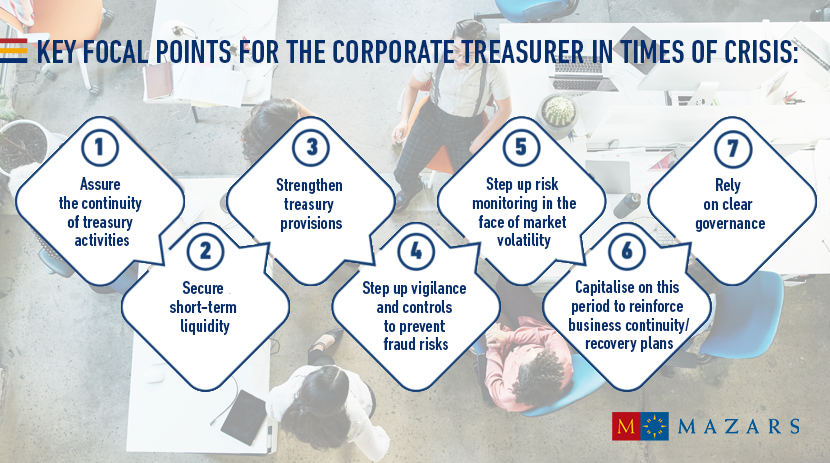COVID-19: SEVEN POINTS OF VIGILANCE FOR CORPORATE TREASURERS
InsightsCOVID-19 InsightsCovid-19: Mazars Global Resource CentreCOVID-19 Mazars Global InsightsBUSINESS CONTINUITY
Seven points of vigilance for corporate treasurers
06/04/2020 The Treasury & Cashflow Management department at Mazars has summarised seven important points for corporate treasurers in times of crisis:
- PLAN FOR THE CONTINUITY OF TREASURY ACTIVITIES
Companies must put in place back-up methods within their treasury departments and plan daily exchanges (for example, through virtual coffee breaks). It is also proper to ensure the availability of treasury applications with the support of IT or other providers if SaaS tools are used. VPN priority access could be considered for actors with a key role in critical cash flow processes (signatories to payments, for example). - SECURE SHORT-TERM LIQUIDITY
The corporate treasurer must secure the availability of short-term liquidity sources while avoiding the systematic default towards credit lines for the sole purpose of building up precautionary cash reserves. Faced with a sharp drop in money market liquidity, companies must analyse the possibility of renewing its draws on credit lines over a longer maturity time-frame and/or negotiating additional back-up lines with banks. - STRENGTHEN THE CASHFLOW FORECAST
Cash flow forecasts need to be strengthened by going beyond existing processes and tools. This involves more frequent exchanges with operational subsidiaries (treasurers and accountants) to conduct an in-depth analysis on the impact of the health crisis on revenue and expenditures. Treasurers should engage in credit management and/or accounts receivable in order to anticipate delays and possible defaults. At the same time, it is essential to prioritise short-term “fixed” expenses, such as salaries. - STEP UP VIGILANCE AND CONTROLS TO PREVENT THE RISK OF FRAUD
Companies must maintain a high level of control to safeguard against fraud risks (phishing attempts, identity theft and/or “fake president” frauds). The escalation in cyberattacks is occurring against a backdrop of uncertainty, loss of bearings and the spread of remote working. Special vigilance must be taken when payment processes are not highly digital. - STEP UP RISK MONITORING IN THE FACE OF INCREASED MARKET VOLATILITY
Risk monitoring (especially counterparty, equity, and exchange rate risks) must be reinforced by setting up additional reports that allow “real-time” visibility of associated exposures and hedges at company level. The treasurer may have to change the horizon of the company’s hedging programmes depending on the liquidity of the currencies. - CAPITALISE ON THIS PERIOD TO STRENGTHEN BUSINESS CONTINUITY/RESUME ACTIVITIES
It is suitable to capitalise on this unprecedented period in order to strengthen and expand upon business continuity/recovery plans. These actions involve formal identification and monitoring of the failures encountered. - RELY ON CLEAR GOVERNANCE
The continuity of treasury activities must be based on clear governance and allow the right level of validation for the various decisions that may need to be urgently made during this period of crisis. Regular communication should be organised with management in order to keep them informed in real time.

